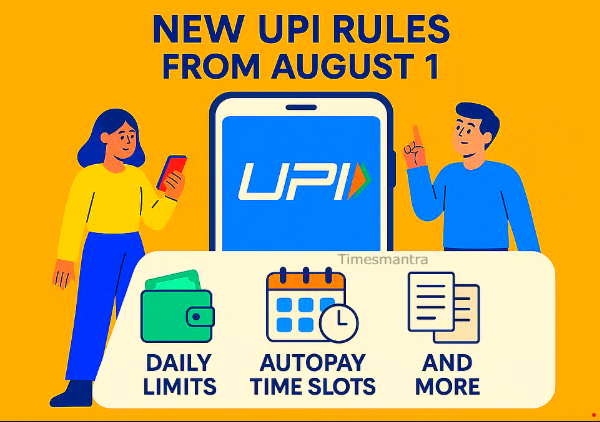New UPI Rules from Aug 1: Limits, Fraud Checks & Timings
Published: August 1, 2025
The National Payments Corporation of India (NPCI) has introduced a new set of rules for the Unified Payments Interface (UPI) ecosystem, effective from August 1, 2025. These changes are a significant step towards enhancing the platform’s stability, security, and overall efficiency, especially as UPI transactions continue to soar.
While these updates might seem like minor tweaks, they are designed to manage system load, prevent fraud, and provide a more reliable experience for millions of users. This article breaks down all the key changes and explains how they will impact your day-to-day digital transactions.
1. Daily Limits on Non-Financial Activities
To prevent system overload and unnecessary API calls, NPCI has introduced strict daily limits on certain non-financial activities. These limits are per app and per user, meaning if you use multiple UPI apps, the limit applies to each one separately.
- Balance Enquiries: The number of times a user can check their account balance has been capped at 50 times per day. This measure is aimed at reducing the strain on bank servers, which are frequently hit by automated or user-initiated balance checks, especially during peak hours. For most users, this limit is generous, but it will impact those who have a habit of checking their balance frequently throughout the day. To compensate, issuer banks are now mandated to include the available balance in every successful transaction confirmation message.
- Linked Account Views: The “list account” API, which allows users to view all bank accounts linked to their mobile number, has also been restricted. You can now access this feature a maximum of 25 times per day per UPI app. This change ensures that this sensitive information is not being accessed unnecessarily, adding a layer of security against potential data scraping attempts. Any retries to list accounts must be done with explicit user consent.
These limits are a proactive step to ensure that critical financial transactions are not hampered by a high volume of non-essential requests.
2. Restrictions on UPI Autopay Timings
UPI Autopay, a popular feature for recurring payments like EMIs, subscriptions, and bill payments, is also undergoing a major change. To alleviate system congestion during high-traffic periods, all UPI Autopay mandates will now be processed only during non-peak hours.
The defined peak hours are from 10:00 AM to 1:00 PM and 5:00 PM to 9:30 PM. Therefore, your automated payments will now be scheduled to execute in one of the following time windows:
- Before 10:00 AM
- Between 1:00 PM and 5:00 PM
- After 9:30 PM
This means that if your Netflix subscription was previously deducted at 11:00 AM, it might now be processed either earlier or later in the day. Users do not need to make any changes to their existing autopay mandates, as the processing will be handled automatically by the banks. However, it is advisable to keep an eye on your account for confirmation to avoid missing a payment. Additionally, each autopay mandate will be allowed one initial attempt and a maximum of three retries before being cancelled.
3. Enhanced Fraud Detection and Prevention
In its continuous effort to combat digital payment fraud, NPCI has rolled out several new measures to make UPI transactions more secure and transparent.
- Mandatory Recipient Name Display: One of the most significant anti-fraud measures is the mandatory display of the recipient’s registered name before every transaction. Previously, some apps would only show the UPI ID. Now, the bank-registered name will be displayed alongside the UPI ID, giving you a crucial final check to ensure you are sending money to the correct person and not a scammer. This is a powerful tool against social engineering scams and impersonation fraud.
- Faster Transaction Status Updates: The new guidelines aim to eliminate the frustration of “pending” transactions. UPI apps are now required to display the final transaction status—either ‘success’ or ‘failure’—within seconds. If a transaction fails, users will be allowed to check its status only three times, with a mandatory 90-second gap between each attempt. This change not only reduces server load but also provides users with a quicker and more definitive resolution.
- First-Time Beneficiary Delay: For added security, a cooling-off period of 4 to 24 hours may be imposed on the very first transaction to a new UPI ID or beneficiary. This is an effective measure to thwart quick, unauthorized transfers in the event of a compromised device or SIM cloning.
4. Impact on Banks and PSPs
The new rules are not just for the end-user; they also impose strict compliance requirements on all banks and Payment Service Providers (PSPs) like Google Pay, PhonePe, and Paytm. NPCI has made it clear that non-compliance with these guidelines by the July 31, 2025 deadline can lead to severe actions, including:
- Restrictions on UPI API access.
- Imposition of penalties.
- Suspension of new customer onboarding.
These measures ensure that all participants in the UPI ecosystem are held accountable for maintaining the performance and security standards required for such a critical national platform.
Summary of Changes
The new UPI rules from August 1 are a crucial evolution of India’s digital payment landscape. They balance the need for user convenience with the imperative of system security and stability. While some changes, like time-restricted autopay, may require a small adjustment in habits, they are all ultimately designed to create a more resilient and trustworthy UPI ecosystem for everyone.
Staying informed about these updates and adapting to the new rules is essential for a seamless and secure digital payment experience.
